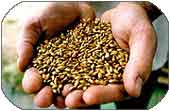|
Beer isn’t as simple as your average six-pack. Here’s an introduction to the building blocks of beer.
Beer basics
Beer is essentially fermented, hop-flavored, malt sugar tea. There are four basic building blocks needed to make beer: water, malted barley, and hops. Yeast is used to ferment the tea into an effervescent liquid with an average of between three and seven percent ethyl alcohol by weight.
Water More than 90 per cent of beer is water, and therefore has a great effect on the taste of the final product. Brewers can, and do, chemically adjust any water to create the exact "style" of beer desired.
Malted Barley Barley, a basic grain, must be "malted" before it can be used in the brewing process. Malting is the process of bringing grain to the point of its highest possible starch content by allowing it to sprout roots, then heating the grain to a temperature that stops growth. Once "malted," barley is high in the enzyme diastase, which converts into a rich sugar called maltose. This sugar is metabolized by the ale or lager yeast to create carbon dioxide and ethyl alcohol.
Portions of this malted barley are then heated at higher temperatures to roast it. This roasted malted barley no longer has the active enzymes needed to turn the starches into sugars, but it does take on characteristics that add to the flavor of the beer.

Yeast Yeast is the organism that metabolizes the sugar (maltose) into ethyl alcohol and carbon dioxide (CO2). The fermentation process is done in two steps. The "primary" fermentation converts most of the maltose to ethyl alcohol and CO2. The "secondary" fermentation finishes metabolizing the remaining sugar into the CO2 necessary to give the beer effervescence.
In traditional beer-making there is also a "priming" that restarts the last of the fermentation in the bottles or kegs. This priming ensures that the beer has natural carbonation. In mass-produced commercial beers and ales, the carbonation is injected into the beer when it is bottled or kegged.
Hops This herb is actually the flower of a perennial vine. Different brewers use different varieties of hops. Each variety has a particular bitter flavor as well as aroma and the two characteristics are important to remember when tasting a beer. The combination of the bitter flavor and floral aroma from the hops, when combined with the sweet and, sometimes astringent, flavors of the malts used in the beer are also influenced by the flavors created by the specific yeast used to ferment the beer.
Additional ingredients Although malt and hops are the main contributors to the flavor of beer and ale, in some cases there are additional flavors. Depending on whether you are drinking a beer or an ale you may also detect flavors that are created by the yeast during fermentation. The ale yeast creates esters that smell like apples, bananas, pears and oranges.
Lager yeast creates much fewer esters, mainly those reminiscent of new-mown hay or, in some cases, citrus. These esters are the exception rather than the rule because lager yeast ferments the sugars much more thoroughly than ale yeasts. Lager yeast takes at least 32 days to complete fermentation, while ale yeast takes a week at most.
|
